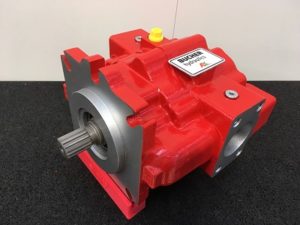The performance of traditional hydraulic pumps has not kept up with increasingly stringent customer demands and new application requirements, according to officials at Bucher Hydraulics, Klettgau, Germany. They’re tackling such concerns with a new design for piston pumps and motors called the AX series. The AX is not an evolutionary improvement over existing products, said the company, but rather a revolutionary new development that technologically leap-frogs current offerings.

The new 24-piston AX pump from Bucher Hydraulics is said to outperform conventional axial-piston units in terms of efficiency, starting torque and speed range.
“We have analyzed the weaknesses of today’s piston units, and there are big disadvantages in certain applications, especially in terms of electrification, winch applications and drives,” said Jan Friedrich, the company’s Head of Marketing. Electrification involves replacing the combustion engine on a mobile machine with an electric motor and batteries as the power source. A major stumbling block when swapping out a noisy engine for a near-silent electric motor, said Friedrich, is it becomes immediately obvious that a traditional piston pump is itself quite loud – and particularly unacceptable for work indoors and in quiet zones near hospitals and schools.
Winch operations are problematic because torque-ripple issues can hurt performance. Efficiency at start-up can be poor. And, last but not least, the devices need better high-pressure performance at low rotary speeds, he continued.
Bucher engineers have significantly altered the design of its new AX pumps to address these shortcomings. “Previously, axial-piston units generally had seven or nine pistons with long strokes,” said Friedrich. “The new AX has 24 pistons with very short strokes.” Each side of the pump contains 12 pistons, with pistons paired to face each other. The resulting forces offset and are completely compensated in the pump and motor units, he explained.
That results in numerous inherent benefits. Due to a mirrored design based on light rotating parts, a maximum pressure limit of 500 bar is possible with negligible pressure ripple. AX units run with minimal vibration even at extremely low speeds (below 1 rpm) because of the short piston stroke, small displacement angle and hydrostatic pressure compensation. They operate much quieter than do conventional piston pumps. And the symmetrical design with low axial forces results in a compact unit with high power density.
AX units are also highly efficient. Mechanical efficiency is up to 99%, even at start-up, because of low friction and direct torque transmission between shaft and pistons. Overall efficiency is up to 94% due to the short stroke, optimized displacement angle, balanced forces and hydrostatic bearing.
Suppliers of conventional piston pumps might also claim efficiencies as high as 94%, but in reality that is only a peak value over a narrow speed range, noted Friedrich. The AX’s 94% efficiency “is like a high plateau” that extends across a wide range of speeds.
“That is a unique capability for electrification,” he said. As there is no longer a minimum speed limit, they are ideally suited for matching the fixed-displacement AX units with variable-speed electric drives. Further, this high level of efficiency in electric-drive mobile machines is essential, as low power losses means valuable battery capacity can be conserved.
The AX’s high starting torque (99% of maximum) that results from the large number of pistons is likewise important in winch-drive applications. Motor and pump units can work below 1 rpm at 500 bar pressure, again thanks to hydrostatic bearings and minimal internal axial forces.
For example, Friedrich noted that in one trial to confirm low-speed performance, Bucher engineers designed a test rig where an AX pump supplied high-pressure flow to compensate for leakage in a cylinder holding a stationary load. The pump ran at a speed of only about one-quarter rpm and exhibited no wear or degradation over the life of the test — although the pump’s electric drive motor tended to overheat, he said.
Engineering features in the AX also point to durability and long life. For instance, low friction in rotating parts prevents wear and stick-slip effects, and less friction means less of a temperature increase. Balanced axial forces reduce stresses on bearings. Bucher officials expect extended periods between maintenance and a long overall life thanks to the robust design.
Displacement in AX series pumps and motors ranges from 18 to 76 cm³/rev, with continuous maximum pressure of 450 bar and a peak 500 bar. Maximum speed is 3,600 rpm. The fixed-displacement, axial-piston units are suited for winches and slew drives, applications related to electrification and energy recovery, and for wheel drives and track drives.
Bucher Hydraulics
www.bucherhydraulics.com
Filed Under: Mobile Hydraulic Tips